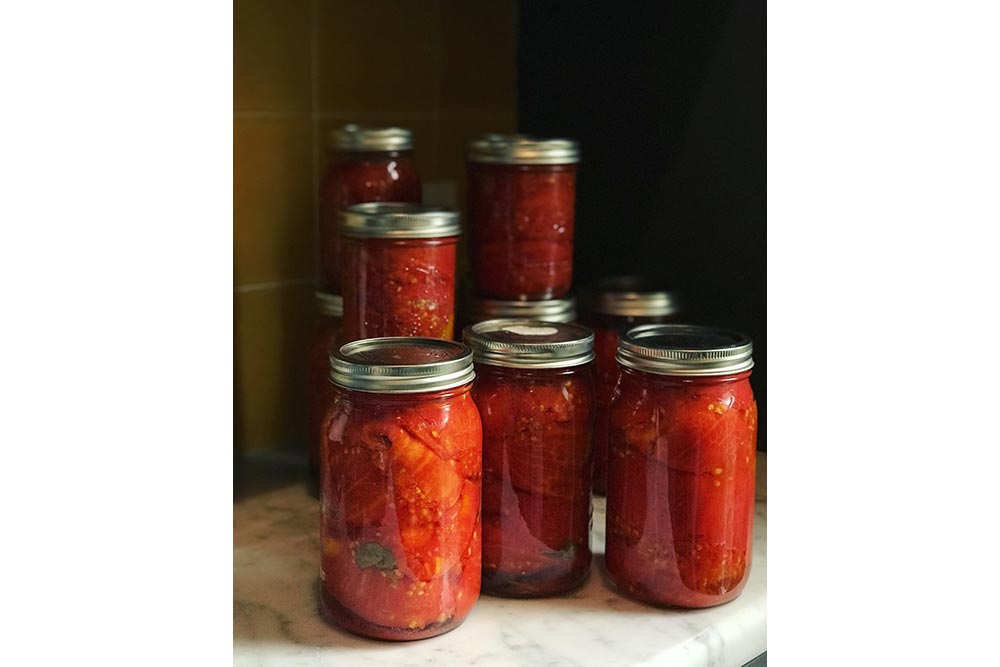Jarred Tomatoes
POSTED UNDER
- canning ,
- preserving ,
- SUMMER
INGREDIENTS
- tomato
It’s great to reuse glass ball jars, but make sure your rings and seals are in good shape. If they have rust, or crud on them, buy new ones. They are cheap and easy to replace.
You need a good amount of surface area for this project, so make sure you have your set up ready to go before you begin. The amount of tomatoes and jars is really up to you. Use what you have, or load up at the farmers market in preparation for a long, cold winter.
- Fresh tomatoes (avoid cherry tomatoes, too much work to peel)
- ½ cup white vinegar
- lemons, 1/2 per jar
- 1 extra large stockpot
- 1 large stockpot
- Rubber tipped tongs or canning tongs
- Clean kitchen towels
Fill the extra large stock pot and the large stock pot ¾ of the way with water, and bring to a boil.
Wash the jars and lids with soap and water, and set on the counter to the left of your large stockpot. Lay a clean dish towel flat on the counter to the right of the range.
Using rubber tongs, place the jars in the pot, allowing them to fill with water and sink to the bottom, right side up. To sterilize, boil for ten minutes, and then remove the jars with tongs and place on the clean kitchen towel to the right of the range. Continue with remaining jars and tops — rings and seals included.
Once everything is sterilized, cover the extra large stockpot and set on a back burner (do not dump the water, we will need to boil again).
Now we will work with the smaller pot of boiling water. To set up your station, place a cutting board to the right of the burner with the smaller pot of boiling water. To the right of the cutting board, you should have your sterilized ball jars and tops. Fill a medium metal prep bowl with ice and cold water, and place on the cutting board. Have a small empty prep bowl next to the ice bath (this will be for the discarded tomato skins), and your halved lemons on-hand. You will need a clean dish towel to wipe the jars before sealing, and a glass or measuring cup with the white vinegar. Wash your hands thoroughly before beginning.
Working with clean tomatoes and a paring knife, slice an X into the stem-end of the tomatoes, lightly piercing the skin, trying not to go deep into the flesh. Place tomatoes into the boiling water, blanching them just until you see the skin peel back. Remove each one with the rubber tipped tongs or with a slotted spoon, and dunk them in the ice bath to stop cooking. Work in batches, filling the pot with a handful at a time, until you have processed all your tomatoes.
When cool to the touch, peel and toss the skins in the small empty prep bowl. Working one jar at a time, place the tomato in the first jar. Fill the jar with peeled tomatoes, pressing them down with your fingertips, submerging them in their own juices as you go. Do not overfill the jar, just fill until you reach the threaded neck. Squeeze the juice of 1/2 lemon into the jar. Dip the tip of your clean dish towel into the boiling water, and then into the white vinegar. Wipe the rim of the jar, to be sure there are no tomato bits hanging out there. We want this point to be as clean as possible. Place the seal on top, and gently screw on the ring. Set the filled jar aside, and continue with remaining jars and tomatoes until complete.
Bring the extra large stockpot back up to a boil, and lay another clean dish towel flat on the counter. Using your canning tongs, rubber tongs, or I use silicone oven mitts, place the jars, rightside up, in the water and boil for ten minutes. Remove from the pot and place on the clean dish towel to cool. You should hear a “pop” sound, as the contents cool, sucking the seal downward, creating an airlock. Before storing, be sure to check and make sure that the seal is tightly on each jar. If they do not seal correctly, they will rot. I check mine a of couple days after jarring to confirm there is not rot as well.
Store in a cool, dark place until winter!

